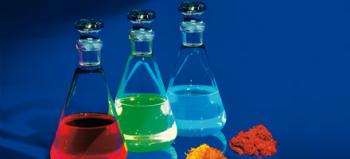In January 2013, Merck said that the performance gap between soluble and evaporable OLED emitters is closed - at least in the lab. Earlier this month at the OLED World Summit the company revealed the development results of their phosphorescent materials, comparing them to UDC's materials (as published on UDC's website).

Merck's red emitter features an efficiency of 19.1cd/A, a lifetime (L90) of 5,900 hours and the CIE is (0.66, 0.34). UDC's red material features an efficiency of 29 cd/A and a lifetime of 23,000 hours. Merck's green material features an of 76.4cd/A, a lifetime of 5,200 hours, and the CIE is (0.32, 0.63). UDCs green features an efficiency of 85 cd/A and lifetime of 18,000 hours, The CIE is similar (0.31, 0.63).
As one can see, Merck's material are still not up to par with UDC's material - especially regarding the lifetime. So soluble OLEDs may be closing the gap on efficiency, but not on lifetime. Hopefully development will continue and Merck (and other companies) will be able to improve those emitters.
Merck recently announced that it has began to construct a new 30 Million Euro OLED production plant in Darmstadt, Germany. This plant will produce high-purity OLED materials for display and lighting systems. Production will begin in the 2,000 square-meter building in July 2016. Merck hopes that the new plan to help it become a leading supplier of OLED materials by 2018, as the company believes that OLED will take a significant share of the display market, and Merck plans to become a total solution provider and not just a material maker.
Comments
1. The materials performance chart (on UDC web site) they site,is for PHOLEDS @ 95% LT, not P2OLEDS .
2. The lifetimes on this chart are from 2012.
3. The P2OLED chart on UDCs web site is what they should compare for soluble PHOLEDs?


This will be of great interest to all those OLED manufacturers making displays that don't include blue, whoever they might be. ;-)